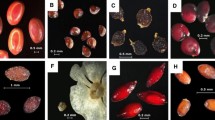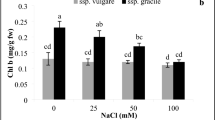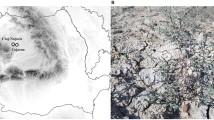Abstract
Halophytic plants growing in extreme environments have developed morphological, anatomical, biochemical and physiological adaptations. In this research, the effect of salinity (up to 500 mM NaCl) on the germination parameters and the antioxidant responses of two halophytic Limonium species was evaluated. Seed germination parameters (rate, speed), ROS production and the contents of phenolic compounds and antioxidant enzymes of Limonium delicatulum and Limonium vulgare were investigated, with respect to their tolerance to salt treatments and their ability to recover from salt stress conditions. L. vulgare seeds were less affected by salt treatments than L. delicatulum, and consequently recovered more rapidly full germination. Moreover, L. vulgare seedlings had more antioxidant phenolics and enzyme activities than L. delicatulum. The highest ability of L. vulgare to recover from salt treatment might be the result of its adaptation to a highly stressful environment constituted by inland salty soil, whereas L. delicatulum grows closer to the sea, thus receiving diluted salt spray. This distinction makes L. vulgare a good candidate for biosaline agriculture as edible crop plant.
Graphical abstract






Similar content being viewed by others

Data availability
All data generated or analyzed during this study are included in this published article.
References
Aebi H (1984) Catalase in vitro. Meth Enzymol 105:121–126
Akyol TY, Yilmaz O, Uzilday B, Uzilday RÖ, Türkan I (2020) Plant response to salinity: an analysis of ROS formation, signaling, and antioxidant defense. Turk J Bot 44:1–13
Alhaddad FA, Abu-Dieyeh MH, Elazazi EM, Ahmed T (2021) Salt tolerance of selected halophytes at the two initial growth stages for future management options. Sci Rep 11:10194
Alom R, Hasan MA, Islam MR, Wang QF (2016) Germination characters and early seedling growth of wheat (Triticum aestivum L.) genotypes under salt stress conditions. J Crop Sci Biotechnol 19:383–392
Arts ICW, Hollman PCH (2005) Polyphenols and disease risk in epidemiologic studies. Am J Clin Nutr 81:317–325
Balkan A, Gençtan T, Bilgin O, Ulukan H (2015) Response of rice (Oryza sativa L.) to salinity stress at germination and early seedling stages. Pak J Agric Sci 52:453–459
Bellani LM, Salvini L, Dell’Aquila A, Scialabba A (2012) Reactive oxygen species release, vitamin E, fatty acid and phytosterol contents of artificially aged radish (Raphanus sativus L.) seeds during germination. Acta Physiol Plant 34:1789–1799
Benzarti M, Rejeb KB, Debez A, Messedi D, Abdelly C (2012) Photosynthetic activity and leaf antioxidative responses of Atriplex portulacoides subjected to extreme salinity. Acta Phys Plant 34:1679–1688
Bertelli A, Biagi M, Corsini M, Baini G, Cappellucci G, Miraldi E (2021) Polyphenols: from theory to practice. Foods 10:2595
Boestfleisch C, Wagenseil NB, Buhmann AK, Seal CE, MerrettWade E, Muscolo A, Papenbrock J (2014) Manipulating the antioxidant capacity of halophytes to increase their cultural and economic value through saline cultivation. AoB Plants. 6:plu046
Bradford MM (1976) A rapid and sensitive method for the quantitation of microgram quantities of protein utilising the principle of protein–dye binding. Anal Biochem 72:248–254
Buhmann A, Papenbrock J (2013) An economic point of view, secondary compounds in halophytes. Funct Plant Biol 40:952–967
Campbell-Martínez GE, Thetford M, Miller D (2022) Germination response of three florida panhandle coastal dune plants to salinity. J Coast Res 38:585–591
Chance B, Maehly A (1955) Assay of catalases and peroxidases. Meth Enzymol 2:764–775
Dewanto V, Wu X, Adom KK, Liu RH (2002) Thermal processing enhances the nutritional value of tomatoes by increasing total antioxidant activity. J Agric Food Chem 50:3010–3014
El-Keblawy A, Elnaggar A, Tammam A, Mosa KA (2020) Seed provenance affects salt tolerance and germination response of the habitat-indifferent Salsola drummondii halophyte in the arid Arabian deserts. Flora 266:151592
Ellouzi H, Rabhi M, Khedher S, Debez A, Abdelly C, Zorrig W (2023) Silicon seed priming enhances salt tolerance of barley seedlings through early ROS detoxification and stimulation of antioxidant defence. SILICON 15:37–60
Falleh H, Jellali I, Ksouri R, Boulâaba M, Guyot S, Magné C, Abdelly C (2012) Effect of salt treatment on phenolic compounds and antioxidant activity of two Mesembryanthemum edule provenances. Plant Physiol Biochem 52:1–8
Giannopolitis CN, Ries SK (1977) Superoxide dismutases I. Occurrence in higher plants. Plant Physiol 59:309–314
Glenn EP, Brown JJ, Blumwald E (1999) Salt tolerance and crop potential of halophytes. CRC Crit Rev Plant Sci 18:227–255
Gul B, Ansari R, Flowers TJ, Khan MA (2013) Germination strategies of halophyte seeds under salinity. Environ Experim Bot 92:4–18
Gyawali S, Parkin IA, Steppuhn H, Buchwaldt M, Adhikari B, Wood R, Hegedus DD (2019) Seedling, early vegetative, and adult plant growth of oilseed rapes (Brassica napus L.) under saline stress. Can J Plant Sci 99:927–941
Hatano T, Kagawa H, Yasuhara T, Okuda T (1988) Two new flavonoids and other constituents in licorice root their relative astringency and radical scavenging effect. Chem Pharm Bull 36:2090–2097
Ivan MA, Zamfirache MM, Grigore MN, Orică L (2012) Determination of antioxidant enzymatic activity in several halophytes from Dobrogea area. An Stiint Univ Al I Cuza Iasi 3:47–52
Jaleel CA, Gopi R, Manivannan P, Panneerselvam P (2007) Antioxidative potentials as a protective mechanism in Catharanthus roseus (L.) G.Don. plants under salinity stress. Turk J Bot 31:245–251
Jallali I, Zaouali Y, Missaoui I, Smaoui A, Abdelly C, Ksouri R (2014) Variability of antioxidant and antibacterial effects of essential oils and acetonic extracts of two edible halophytes: Crithmum maritimum L. and Inula crithmoїdes L. Food Chem 145:1031–1038
Jenks MA, Hasegawa PM (2005) Plant abiotic stress. Blackwell Publishing Ltd, Hoboken
Khan MA, Gul B (2006) Halophyte seed germination. In: Khan MA, Gul B (eds) Ecophysiology of high salinity tolerant plants, vol 40. Springer, Dordrecht, pp 10–30
Khan MA, Ungar IA (1998) Germination of salt tolerant shrub Suaeda fruticosa from Pakistan: salinity and temperature responses. Seed Sci Technol 26:657–667
Koyro HW, Lieth H, Gul B, Ansari R, Huchzermeyer B, Abideen Z, Hussain T, Khan MA (2014) Importance of the diversity within the halophytes to agriculture and land management in Arid and Semiarid countries. In: Khan MA, Böer B, Öztürk M, Al Abdessalaam TZ, Clüsener-Godt M, Gul B (eds) Sabkha ecosystems. Tasks for vegetation science, vol 47. Springer, Dordrecht
Ksouri R, Megdiche W, Debeza A, Falleh H, Grignon C, Abdelly C (2007) Salinity effects on polyphenol content and antioxidant activities in leaves of the halophyte Cakile maritima. Plant Physiol Biochem 45:244–249
Ksouri R, Megdiche Ksouri W, Jallali I, Debez A, Magné C, Hiroko I, Abdelly C (2012) Medicinal halophytes: potent source of health promoting biomolecules with medical, nutraceutical and food applications. Crit Rev Biotechnol 32:289–326
Kumar D, Yusuf MA, Singh P, Sardar M, Sarin NB (2014) Histochemical detection of superoxide and H2O2 accumulation in Brassica juncea seedlings. Bio Protoc 4:e1108
Kumari A, Das P, Parida AK, Agarwal PK (2015) Proteomics, metabolomics, and ionomics perspectives of salinity tolerance in halophytes. Front Plant Sci 6:537
Mittler R, Vanderauwera S, Gollery M, Van Breusegem F (2004) Reactive oxygen gene network of plants. Trends Plant Sci 9:490–498
Nakano Y, Asada K (1981) Hydrogen peroxide is scavenged by ascorbate-specific peroxidase in spinach chloroplasts. Plant Cell Physiol 22:867–880
Navarro JM, Flores P, Garrido C, Martinez V (2006) Changes in the contents of antioxidant compounds in pepper fruits at ripening stages, as affected by salinity. Food Chem 96:66–73
Nisar F, Gul B, Ajmal Khan M, Hameed A (2019) Germination and recovery responses of heteromorphic seeds of two co-occurring Arthrocnemum species to salinity, temperature and light. S Afr J Bot 121:143–151
Pereira GJG, Molina SMG, Lea PJ, Azevedo RA (2002) Activity of antioxidant enzymes in response to cadmium in Crotalaria juncea. Plant Soil 239:123–132
Rozema J, Flowers T (2008) Crops for a salinized world. Science 322:1478–1480
Rubio-Casal AE, Castillo JM, Luque CJ, Figueroa ME (2003) Influence of salinity on germination and seeds viability of two primary colonizers of Mediterranean salt pans. J Arid Environ 53:145–154
Scalbert A, Manach C, Morand C, Rémésy C, Jiménez L (2005) Dietary polyphenols and the prevention of diseases. Crit Rev Food Sci Nutr 45:287–306
Souid A, Gabriele M, Longo V, Pucci L, Bellani LM, Smaoui A, Abdelly C, Ben Hamed K (2016) Salt tolerance of the halophyte Limonium delicatulum is more associated with antioxidant enzyme activities than phenolic compounds. Funct Plant Biol 43:607–619
Souid A, Bellani L, Magné C, Zorrig W, Smaoui A, Abdelly C, Longo V, Ben Hamed K (2018) Physiological and antioxidant responses of the sabkha biotope halophyte Limonium delicatulum to seasonal changes in environmental conditions. Plant Physiol Biochem 123:180–191
Souid A, Bellani L, Gabriele M, Pucci L, Smaoui A, Abdelly C, Ben Hamed K, Longo V (2019) Phytochemical and biological activities in Limonium species collected in different biotopes of Tunisia. Chem Biodiv 16:e190021
Sozharajan R, Natarajan S (2014) Germination and seedling growth of Zea mays L. under different levels of sodium chloride stress. Int Lett Nat Sci 12:5–15
Srivastava AK, Srivastava S, Lokhande VH, D’Souza SF, Suprasanna P (2015) Salt stress reveals differential antioxidant and energetics responses in glycophyte (Brassica juncea L.) and halophyte (Sesuvium portulacastrum L.). Front Environ Sci 3:19
Uzilday B, Ozgur R, Sekmen AH, Yildiztugay E, Turkan I (2014) Changes in the alternative electron sinks and antioxidant defence in chloroplasts of the extreme halophyte Eutrema parvulum (Thellungiella parvula) under salinity. Ann Bot 115:449–463
Wang M, Ren T, Huang R, Li Y, Zhang C, Xu Z (2021) Overexpression of an Apocynum venetum flavonols synthetase gene confers salinity stress tolerance to transgenic tobacco plants. Plant Physiol Biochem 162:667–676
Yang G, Liu S, Yan K, Tian L, Li P, Li X, He X (2020) Effect of drip irrigation with brackish water on the soil chemical properties for a typical desert plant (Haloxylon ammodendron) in the manas river basin. Irrig Drain 69:460–471
Younis ME, Rizwan M, Tourky SMN (2021) Assessment of early physiological and biochemical responses in chia (Salvia hispanica L.) sprouts under salt stress. Acta Phys Plant 43:121
Acknowledgements
This study was supported by the Tunisian Ministry of Higher Education and Scientific Research (LR15CBBC02) and by the Institute of Agricultural Biology and Biotechnology (IBBA) of National Research Council (CNR) Pisa, Italy. Also, we acknowledge Pr. Walid ZORRIG (Laboratoire des Plantes Extrêmophiles, Centre de Biotechnologie de Borj Cedria, Tunisia) for his scientific support.
Funding
This research did not receive any specific grant from funding agencies in the public, commercial or not-for-profit sectors.
Author information
Authors and Affiliations
Corresponding author
Ethics declarations
Conflict of interest
The authors declare no conflict of interest.
Additional information
Communicated by A. Gniazdowska-Piekarska.
Publisher's Note
Springer Nature remains neutral with regard to jurisdictional claims in published maps and institutional affiliations.
Supplementary Information
Below is the link to the electronic supplementary material.
Rights and permissions
Springer Nature or its licensor (e.g. a society or other partner) holds exclusive rights to this article under a publishing agreement with the author(s) or other rightsholder(s); author self-archiving of the accepted manuscript version of this article is solely governed by the terms of such publishing agreement and applicable law.
About this article
Cite this article
Souid, A., Giorgetti, L., Smaoui, A. et al. Germination and antioxidant responses to salt stress of Tunisian endemic Limonium species at early vegetative stage. Acta Physiol Plant 46, 7 (2024). https://doi.org/10.1007/s11738-023-03632-6
Received:
Revised:
Accepted:
Published:
DOI: https://doi.org/10.1007/s11738-023-03632-6



